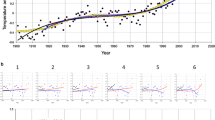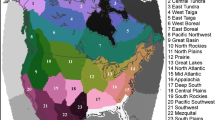Abstract
The unexpected global warming slowdown during 1998–2013 challenges the existing scientific understanding of global temperature change mechanisms, and thus the simulation and prediction ability of state-of-the-art climate models since most models participating in phase 5 of the Coupled Model Intercomparison Project (CMIP5) cannot simulate it. Here, we examine whether the new-generation climate models in CMIP6 can reproduce the recent global warming slowdown, and further evaluate their capacities for simulating key-scale natural variabilities which are the most likely causes of the slowdown. The results show that although the CMIP6 models present some encouraging improvements when compared with CMIP5, most of them still fail to reproduce the warming slowdown. They considerably overestimate the warming rate observed in 1998–2013, exhibiting an obvious warming acceleration rather than the observed deceleration. This is probably associated with their deficiencies in simulating the distinct temperature change signals from the human-induced long-term warming trend and or the three crucial natural variabilities at interannual, interdecadal, and multidecadal scales. In contrast, the 4 models that can successfully reproduce the slowdown show relatively high skills in simulating the long-term warming trend and the three key-scale natural variabilities. Our work may provide important insight for the simulation and prediction of near-term climate changes.
Similar content being viewed by others
References
Banholzer S, Donner S. 2014. The influence of different El Niño types on global average temperature. Geophys Res Lett, 41: 2093–2099
Bellenger H, Guilyardi E, Leloup J, Lengaigne M, Vialard J. 2014. ENSO representation in climate models: From CMIP3 to CMIP5. Clim Dyn, 42: 1999–2018
Chen X, Tung K K. 2014. Varying planetary heat sink led to global-warming slowdown and acceleration. Science, 345: 897–903
Chen X, Tung K K. 2018a. Global-mean surface temperature variability: Space-time perspective from rotated EOFs. Clim Dyn, 51: 1719–1732
Chen X, Tung K K. 2018b. Global surface warming enhanced by weak Atlantic overturning circulation. Nature, 559: 387–391
Cheng L, Wang G, Abraham J, Huang G. 2018. Decadal ocean heat redistribution since the late 1990s and its association with key climate modes. Climate, 6: 91
Cowtan K, Way R G. 2014. Coverage bias in the HadCRUT4 temperature series and its impact on recent temperature trends. QJR Meteorol Soc, 140: 1935–1944
Dai A, Fyfe J C, Xie S P, Dai X. 2015. Decadal modulation of global surface temperature by internal climate variability. Nat Clim Change, 5: 555–559
England M H, McGregor S, Spence P, Meehl G A, Timmermann A, Cai W, Gupta A S, McPhaden M J, Purich A, Santoso A. 2014. Recent intensification of wind-driven circulation in the Pacific and the ongoing warming hiatus. Nat Clim Change, 4: 222–227
Eyring V, Bony S, Meehl G A, Senior C A, Stevens B, Stouffer R J, Taylor K E. 2016. Overview of the Coupled Model Intercomparison Project Phase 6 (CMIP6) experimental design and organization. Geosci Model Dev, 9: 1937–1958
Fyfe J C, Gillett N P, Zwiers F W. 2013. Overestimated global warming over the past 20 years. Nat Clim Change, 3: 767–769
Gong H, Wang L, Chen W, Chen X, Nath D. 2017. Biases of the wintertime Arctic Oscillation in CMIP5 models. Environ Res Lett, 12: 014001
Gong H, Wang L, Chen W, Wu R. 2019. Time-varying contribution of internal dynamics to wintertime land temperature trends over the Northern Hemisphere. Geophys Res Lett, 46: 14674–14682
Guemas V, Doblas-Reyes F J, Andreu-Burillo I, Asif M. 2013. Retrospective prediction of the global warming slowdown in the past decade. Nat Clim Change, 3: 649–653
Guilyardi E, Bellenger H, Collins M, Ferrett S, Cai W, Wittenberg A. 2012. A first look at ENSO in CMIP5. CLIVAR Exchang, 17: 29–32
Hansen J, Ruedy R, Sato M, Lo K. 2010. Global surface temperature change. Rev Geophys, 48: G4004
Huang J, Xie Y, Guan X, Li D, Ji F. 2017. The dynamics of the warming hiatus over the Northern Hemisphere. Clim Dyn, 48: 429–446
Huang N E, Shen Z, Long S R, Wu M C, Shih H H, Zheng Q, Yen N C, Tung C C, Liu H H. 1998. The empirical mode decomposition and the Hilbert spectrum for nonlinear and non-stationary time series analysis. Proc R Soc Lond A, 454: 903–995
IPCC. 2013. Climate Change 2013: The Physical Science Basis. Contribution of Working Group I to the Fifth Assessment Report of the Intergovernmental Panel on Climate Change. In: Stocker T F, Qin D, Plattner G K, Tignor M, Allen S K, Boschung J, Nauels A, Xia Y, Bex V and Midgley P M, eds. Technical Summary Cambridge: Cambridge University Press. 1535
Ji F, Wu Z, Huang J, Chassignet E P. 2014. Evolution of land surface air temperature trend. Nat Clim Change, 4: 462–466
Joshi M K, Kucharski F. 2017. Impact of Interdecadal Pacific Oscillation on Indian summer monsoon rainfall: An assessment from CMIP5 climate models. Clim Dyn, 48: 2375–2391
Kajtar J B, Collins M, Frankcombe L M, England M H, Osborn T J, Juniper M. 2019. Global Mean surface temperature response to large-scale patterns of variability in observations and CMIP5. Geophys Res Lett, 46: 2232–2241
Kim S T, Yu J Y. 2012. The two types of ENSO in CMIP5 models. Geophys Res Lett, 39: L11704
Knight J R, Allan R J, Folland C K, Vellinga M, Mann M E. 2005. A signature of persistent natural thermohaline circulation cycles in observed climate. Geophys Res Lett, 32: L20708
Knight J R, Kennedy J J, Folland C, Harris G, Jones G S, Palmer M, Parker D, Scaife A, Stott P. 2009. Do global temperature trends over the last decade falsify climate predictions? In: State of the Climate in 2008. Bull Amer Meteorol Soc, 90: S22–S23
Kosaka Y, Xie S P. 2013. Recent global-warming hiatus tied to equatorial Pacific surface cooling. Nature, 501: 403–407
Lean J L, Rind D H. 2009. How will Earth’s surface temperature change in future decades? Geophys Res Lett, 36: L15708
Liu W, Xie S. 2018. An ocean view of the global surface warming hiatus. Oceanography, 31: 72–79
Loeb N G, Lyman J M, Johnson G C, Allan R P, Doelling D R, Wong T, Soden B J, Stephens G L. 2012. Observed changes in top-of-the-atmosphere radiation and upper-ocean heating consistent within uncertainty. Nat Geosci, 5: 110–113
Martin E R, Thorncroft C, Booth B B B. 2013. The multidecadal Atlantic SST—Sahel rainfall teleconnection in CMIP5 simulations. J Clim, 27: 784–806
Meehl G A, Arblaster J M, Fasullo J T, Hu A, Trenberth K E. 2011. Modelbased evidence of deep-ocean heat uptake during surface-temperature hiatus periods. Nat Clim Change, 1: 360–364
Meehl G A, Boer G J, Covey C, Latif M, Stouffer R J. 1997. Intercomparison makes for a better climate model. Eos Trans AGU, 78: 445–451
Meehl G A, Hu A, Arblaster J M, Fasullo J, Trenberth K E. 2013. Externally forced and internally generated decadal climate variability associated with the Interdecadal Pacific Oscillation. J Clim, 26: 7298–7310
Morice C P, Kennedy J J, Rayner N A, Jones P D. 2012. Quantifying uncertainties in global and regional temperature change using an ensemble of observational estimates: The HadCRUT4 data set. J Geophys Res, 117: D08101
Risbey J S, Lewandowsky S, Langlais C, Monselesan D P, O’Kane T J, Oreskes N. 2014. Well-estimated global surface warming in climate projections selected for ENSO phase. Nat Clim Change, 4: 835–840
Rohde R, Muller R A, Jacobsen R, Muller E, Perlmutter S, Rosenfeld A, Wurtele J, Groom D, Wickham C. 2013. A new estimate of the average earth surface land temperature spanning 1753 to 2011. Geostat: An Overview 1
Santer B D, Bonfils C, Painter J F, Zelinka M D, Mears C, Solomon S, Schmidt G A, Fyfe J C, Cole J N S, Nazarenko L, Taylor K E, Wentz F J. 2014. Volcanic contribution to decadal changes in tropospheric temperature. Nat Geosci, 7: 185–189
Smith D M, Allan R P, Coward A C, Eade R, Hyder P, Liu C, Loeb N G, Palmer M D, Roberts C D, Scaife A A. 2015. Earth’s energy imbalance since 1960 in observations and CMIP5 models. Geophys Res Lett, 42: 1205–1213
Solomon S, Rosenlof K H, Portmann R W, Daniel J S, Davis S M, Sanford T J, Plattner G K. 2010. Contributions of stratospheric water vapor to decadal changes in the rate of global warming. Science, 327: 1219–1223
Solomon S, Daniel J S, Neely R R, Vernier J P, Dutton E G, Thomason L W. 2011. The persistently variable “background” stratospheric aerosol layer and global climate change. Science, 333: 866–870
Stauning P. 2014. Reduced solar activity disguises global temperature rise. ACS, 04: 60–63
Taylor K E, Stouffer R J, Meehl G A. 2012. An overview of CMIP5 and the experiment design. Bull Am Meteorol Soc, 93: 485–498
Thompson D W J, Wallace J M. 2001. Regional climate impacts of the Northern Hemisphere annular mode. Science, 293: 85–89
Trenberth K E, Fasullo J T. 2013. An apparent hiatus in global warming? Earth’s Future, 1: 19–32
Tung K K, Zhou J. 2013. Using data to attribute episodes of warming and cooling in instrumental records. Proc Natl Acad Sci USA, 110: 2058–2063
Vose R S, Arndt D, Banzon V F, Easterling D R, Gleason B, Huang B, Kearns E, Lawrimore J H, Menne M J, Peterson T C, Reynolds R W, Smith T M, Williams Claude N. J, Wuertz D B. 2012. NOAA’s merged land-ocean surface temperature analysis. Bull Am Meteorol Soc, 93: 1677–1685
Wei M, Qiao F L. 2017. Attribution analysis for the failure of CMIP5 climate models to simulate the recent global warming hiatus. Sci China Earth Sci, 60: 397–408
Wei M, Qiao F, Guo Y, Deng J, Song Z, Shu Q, Yang X. 2019. Quantifying the importance of interannual, interdecadal and multidecadal climate natural variabilities in the modulation of global warming rates. Clim Dyn, 53: 6715–6727
Wu Z, Huang N E, Long S R, Peng C K. 2007. On the trend, detrending, and variability of nonlinear and nonstationary time series. Proc Natl Acad Sci USA, 104: 14889–14894
Wu Z, Huang N E. 2009. Ensemble empirical mode decomposition: A noise-assisted data analysis method. Adv Adapt Data Anal, 01: 1–41
Wu Z, Huang N E, Wallace J M, Smoliak B V, Chen X. 2011. On the time-varying trend in global-mean surface temperature. Clim Dyn, 37: 759–773
Xie S P, Kosaka Y. 2017. What caused the global surface warming hiatus of 1998–2013? Curr Clim Change Rep, 3: 128–140
Zhang L. 2016. The roles of external forcing and natural variability in global warming hiatuses. Clim Dyn, 47: 3157–3169
Zhang L, Delworth T L. 2015. Analysis of the characteristics and mechanisms of the pacific decadal oscillation in a suite of coupled models from the geophysical fluid dynamics laboratory. J Clim, 28: 7678–7701
Zhang T, Sun D Z. 2014. ENSO asymmetry in CMIP5 models. J Clim, 27: 4070–4093
Acknowledgements
We thank all the data providers. This work was supported by the National Natural Science Foundation of China (Grant No. 41806043), the Basic Scientific Fund for National Public Research Institutes of China (Grant No. 2019Q08), the National Natural Science Foundation of China (Grant No. 41821004), the Basic Scientific Fund for National Public Research Institute of China (Shu Xingbei Young Talent Program Grant No. 2019S06), the National Program on Global Change and Air-Sea Interaction (Grant No. GASI-IPOVAI-06), and the National Natural Science Foundation of China (Grant No. 41906029).
Author information
Authors and Affiliations
Corresponding author
Supplemental Material
Rights and permissions
About this article
Cite this article
Wei, M., Shu, Q., Song, Z. et al. Could CMIP6 climate models reproduce the early-2000s global warming slowdown?. Sci. China Earth Sci. 64, 853–865 (2021). https://doi.org/10.1007/s11430-020-9740-3
Received:
Revised:
Accepted:
Published:
Issue Date:
DOI: https://doi.org/10.1007/s11430-020-9740-3




